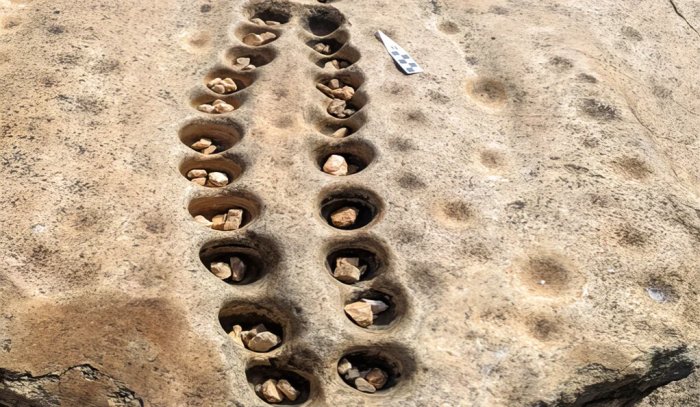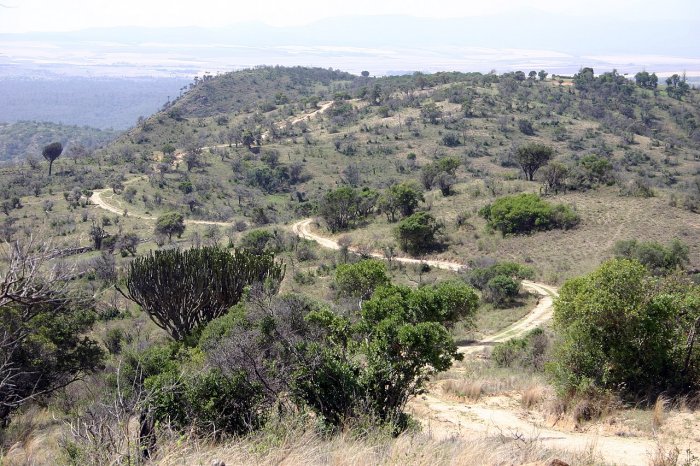Jan Bartek – AncientPages.com – Ancient people have demonstrated their creative abilities countless times, and this stunning archaeological discovery again proves it is possible to do much with little means.
Veronica Waweru, an archaeologist from Yale University who was conducting fieldwork in Kenya, has found an “arcade” of ancient Mancala game boards carved on rocks.

The Yale archaeologist discovered rows of shallow pits drilled into rock used to play the board game, Mancala. Credit: Veronica Waweru
Board games have been with us for as long as anyone can remember, and they have never gone out of fashion. A popular board game that has survived the test of time is Mancala. The word mancala is derived from the Arabic word naqala, which means “to move.” When and where the first mancala games appeared is uncertain. The birthplace of Mancala games is most likely Africa or the Middle East, and the game was played between 3,000 and 1,000 B.C. It has also been proposed the game mancala may have originated as far back as 6000 B.C. in Jordan.
The game consists of stones that players move between a series of small pits on a wooden game board. The point of the game is to get all the stones into the last pit at the end of the board. Scientists who studied Mancala say the ancient board game can unlock cutting-edge physics discoveries.
Waweru was not looking into modern scientific problems while being in Kenya. As an archaeologist, she focused her attention on prehistoric sites and examination of ancient artifacts. When she learned from the Lewa Wildlife Conservancy about a hand-axe site, which was previously known but had never been excavated or dated, she decided to investigate it closer. It was then she stumbled upon something entirely different.
A series of rows of shallow pits drilled into a rock ledge caught Waweru’s attention. Some of the pits had eroded into pockmarks. Others were deep enough to comfortably hold a handful of stones. The varying levels of erosion in the pits suggested that they were formed at different times. This discovery led Waweru to theorize that ancient people used them to play a form of the game Mancala.
“It’s a valley full of these game boards, like an ancient arcade,” said Waweru. “Given the erosion of some of the boards, I believe people were playing these games there a very long time ago.”
Waweru also noticed the Mancala gameboards shared the site with the 19 burial cairns and pondered if there might be some connection between the sites. Were some ancient rituals perhaps practiced at these sites?

The road to the Lewa Wildlife Conservancy. Credit: Kevin Walsh – CC BY 2.0
“There is always a water source there,” Waweru said. “That could be a reason why very early human ancestors came there. It’s been occupied over and over again throughout time. Within the last 10 thousand years, people played Mancala there.”
“It is challenging to determine the exact age of the game boards since they are carved into rock that is 400 million years old,” Waweru explained. She also suggested that DNA analysis of the materials discovered in the burial mounds might help establish the connection between the people buried in them and modern-day humans.
See also: More Archaeology News
“It’s possible the burial mounds were being reopened, and new bodies were being interred in them,” she said. “That has been known to have happened at other prehistoric sites.”
Playing Mancala has been a popular spare-time activity among people in this region. There were herding societies in the area 5,000 years ago at the earliest.
“Modern people in the region tend to play games like Mancala when they are out herding,” she said. “That’s probably what they were doing here. People tend to look at early life as brutish, nasty, and short. But perhaps life was not all about survival.”
Written by Jan Bartek – AncientPages.com Staff Writer





